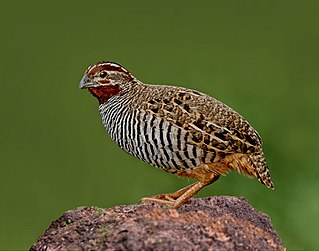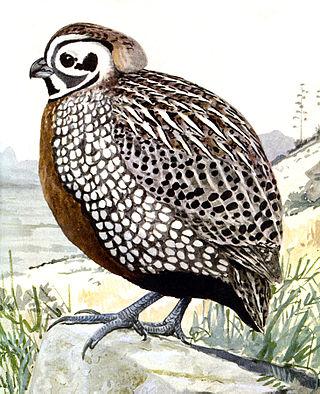
The northern bobwhite, also known as the Virginia quail or bobwhite quail, is a ground-dwelling bird native to Canada, the United States, Mexico, and Cuba, with introduced populations elsewhere in the Caribbean, Europe, and Asia. It is a member of the group of species known as New World quail (Odontophoridae). They were initially placed with the Old World quail in the pheasant family (Phasianidae), but are not particularly closely related. The name "bobwhite" is an onomatopoeic derivation from its characteristic whistling call. Despite its secretive nature, the northern bobwhite is one of the most familiar quails in eastern North America, because it is frequently the only quail in its range. Habitat degradation has contributed to the northern bobwhite population in eastern North America declining by roughly 85% from 1966 to 2014. This population decline is apparently range-wide and continuing.

The Phasianidae are a family of heavy, ground-living birds, which includes pheasants, partridges, junglefowl, chickens, turkeys, Old World quail, and peafowl. The family includes many of the most popular gamebirds. The family is a large one and includes 185 species divided into 54 genera. It was formerly broken up into two subfamilies, the Phasianinae and the Perdicinae. However, this treatment is now known to be paraphyletic and polyphyletic, respectively, and more recent evidence supports breaking it up into two subfamilies: Rollulinae and Phasianinae, with the latter containing multiple tribes within two clades. The New World quail (Odontophoridae) and guineafowl (Numididae) were formerly sometimes included in this family, but are now typically placed in families of their own; conversely, grouse and turkeys, formerly often treated as distinct families, are now known to be deeply nested within Phasianidae, so they are now included in the present family.

The common quail, or European quail, is a small ground-nesting game bird in the pheasant family Phasianidae. It is mainly migratory, breeding in the western Palearctic and wintering in Africa and southern India.

Coturnix is a genus of five extant species and five to eight known extinct species of Old World quail.

The Himalayan quail or mountain quail, is a medium-sized quail belonging to the pheasant family. It was last reported in 1876 and is feared extinct. This species was known from only 2 locations in the western Himalayas in Uttarakhand, north-west India. The last verifiable record was in 1876 near the hill station of Mussoorie.

The rain quail or black-breasted quail is a species of quail found in the Indian Sub-continent and South-east Asia; its range including Pakistan, India, Nepal, Sri Lanka, Bangladesh, Myanmar, Thailand, Cambodia and Vietnam.

The jungle bush quail is a species of quail in the family Phasianidae. It is native to the Indian subcontinent, where it is found in peninsular India and Sri Lanka. It has also been reported from Nepal but has not been seen there since the 19th century, and an introduced population exists on the island of Réunion. A small species of quail 15–18 cm (5.9–7.1 in) long and weighing 57–82 g (2.0–2.9 oz), it shows significant sexual dimorphism. Males have brown upperparts with blackish and buff marking and whitish underparts with black barring. The face is mainly dark reddish-brown, with brown ear-coverts, a buffy-white moustachial stripe, and the supercilium turning whitish towards the back of the neck. Females have a similar pattern, but with pinkish-brown underparts, more uniform wings, and duller moustachial stripes.

The Montezuma quail is a stubby, secretive New World quail of Mexico and some nearby parts of the United States. It is also known as Mearns's quail, the harlequin quail, and the fool quail.

The brown quail, also known as the swamp quail, silver quail and Tasmanian quail, is an Australasian true quail of the family Phasianidae. It is a small, ground-dwelling bird and is native to mainland Australia, Tasmania and Papua New Guinea and has been introduced to New Zealand and Fiji. Widespread and common throughout its large range, the brown quail is evaluated as being of "least concern" by the International Union for Conservation of Nature on the IUCN Red List of Threatened Species.

The blue quail or African blue quail is a species of bird in the family Phasianidae found in sub-Saharan Africa.

The chestnut wood quail is a bird species in the family Odontophoridae, the New World quail. It is found only in Colombia.

The dark-backed wood quail is a bird species in the family Odontophoridae, which is the New World quail. It is found in Colombia and Ecuador.

The black-eared wood quail is a bird species in the order Galliformes. Until recently, the species was thought to be part of the family Phasianidae however DNA-DNA hybridization results determined that black-eared wood quail are only distantly related to Old World quail. As a result, black-eared wood quail have been placed in the family Odontophoridae and more specifically, in the category of wood quail.

The spot-bellied bobwhite is a ground-dwelling bird in the New World quail family. It is sometimes considered to be conspecific with the crested bobwhite, Colinus cristatus. As the latter species expands north into Costa Rica, it is likely that the two species will overlap in range in the future, but the Costa Rican subspecies of the spot-bellied is the least similar to the crested.

Haemoproteus is a genus of alveolates that are parasitic in birds, reptiles, and amphibians. Its name is derived from Greek: haima 'blood' and Proteus, a sea god that had the power to assume various shapes. The name Haemoproteus was first used in the description of H. columbae in the blood of the pigeon Columba livia by Walther Kruse in 1890. This was also the first description of this genus. Two other genera—Halteridium and Simondia—are now considered to be synonyms of Haemoproteus.

Perdicinae is a polyphyletic former subfamily of birds in the pheasant family, Phasianidae, regrouping the partridges, Old World quails, and francolins. Although this subfamily was considered monophyletic and separated from the pheasants, tragopans, junglefowls, and peafowls (Phasianinae) till the early 1990s, molecular phylogenies have shown that these two subfamilies actually constitute only one lineage. For example, some partridges are more closely affiliated to pheasants, whereas Old World quails and partridges from the Alectoris genus are closer to junglefowls. Due to this, the subfamily Perdicinae is no longer recognized by the International Ornithological Congress, with the species being split among 3 subfamilies.

Old World quail is a collective name for several genera of mid-sized birds in the tribe Coturnicini of the pheasant family Phasianidae. Although all species commonly referred to as "Old World quail" are in the same tribe, they are paraphyletic with respect to the other members of the tribe, such as Alectoris, Tetraogallus, Ammoperdix, Margaroperdix, and Pternistis.


















